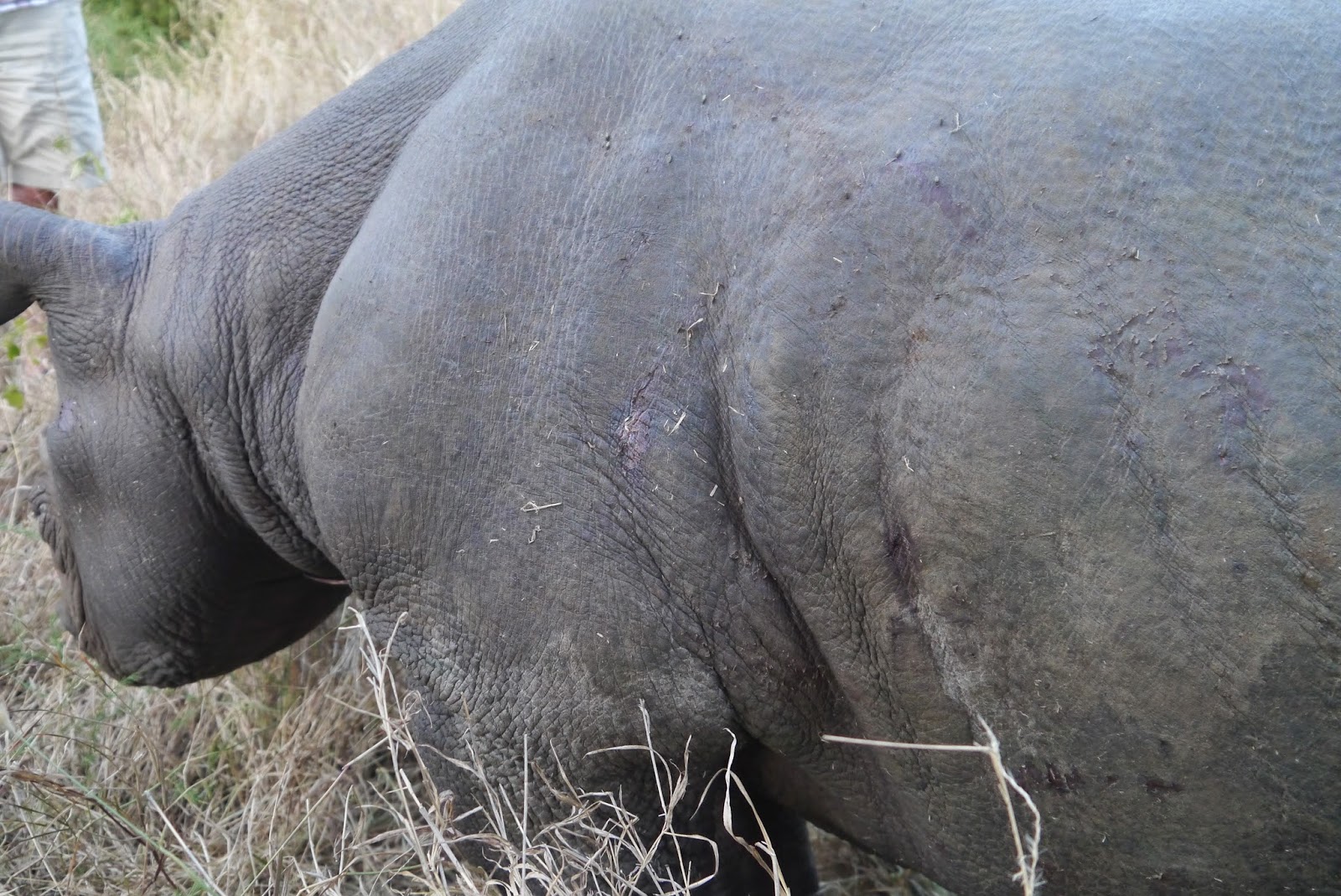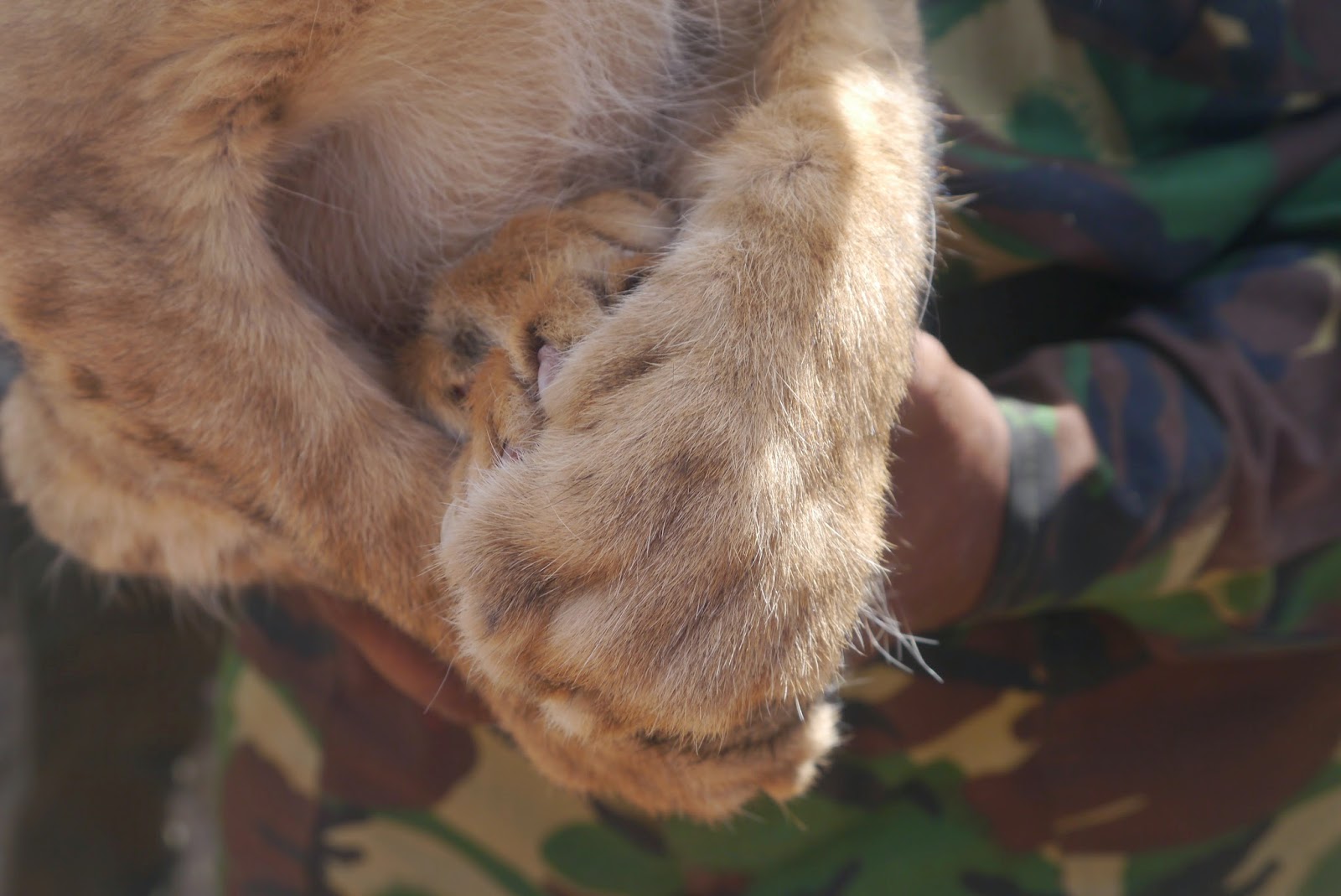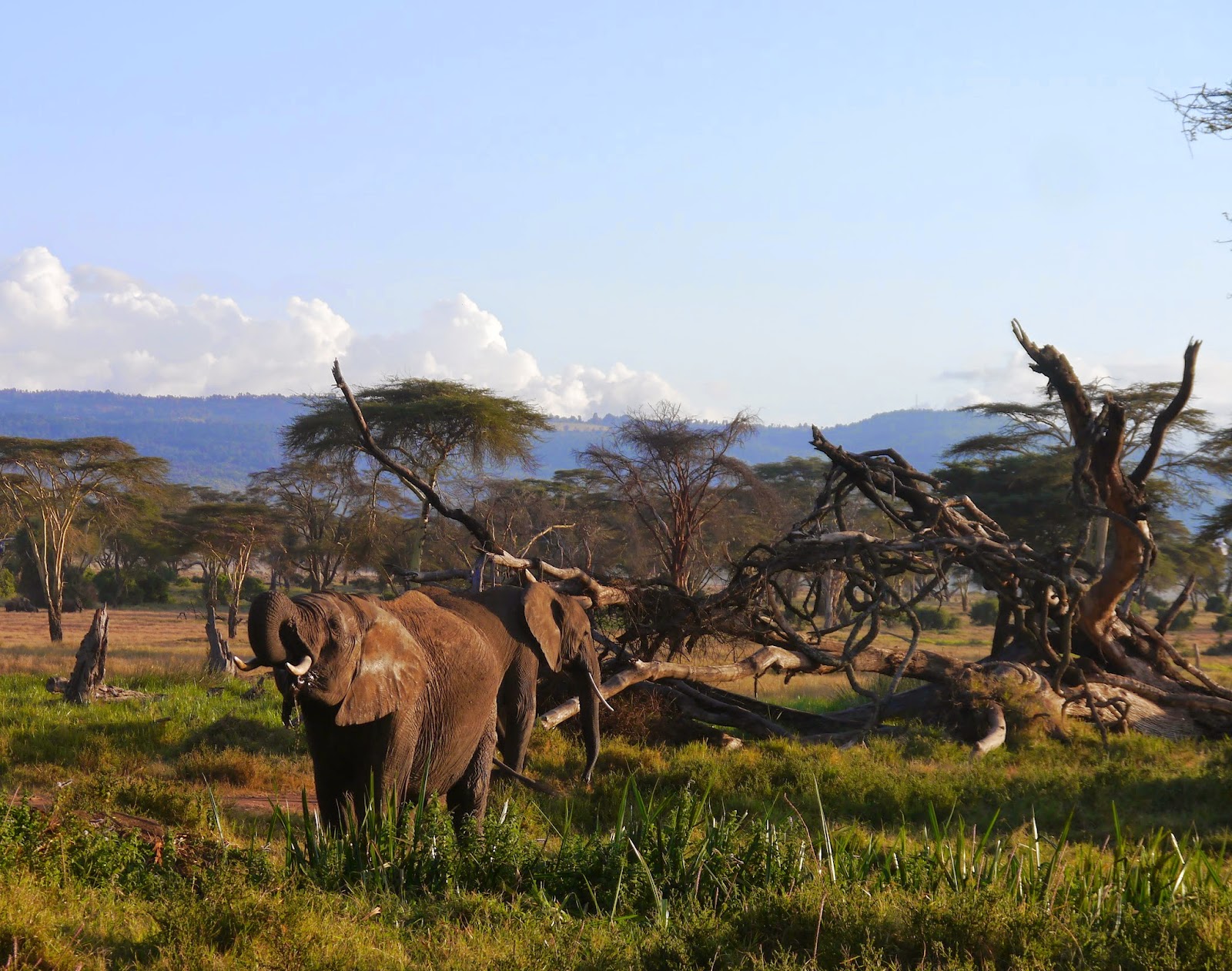 |
| In the field…in the Mobile Vet Unit |
So Thursday was spent setting up the
lab. I was preparing for my hartebeest
project. It felt good, and like old times, to be in the lab. Tim, Mathenge, and I went to the field to
collect samples. It took us about 2
hours to find the Hartebeests. They are
remarkably well camouflaged, as are most of the species here. We were only able to collect 1 fecal sample,
but it was a start. Whilst we were
finishing up in the field, so much commotion started on the walkie-talkie
system. So many people were talking. I kept catching some words. I figured out that Elvis (the rhino in the
hut) had attacked the 3 orphan rhino babies that I have gone to see two times.
 |
| Jackal I saw on the way to see the baby rhinos |
There was no hesitation in my voice when I
said “Yes” when Mathenge asked if I wanted to go and look at the babies.
Mutinda was at a meeting in Nanyuki, so I suddenly became the “vet” on
site. We left the field and rushed over
to where the attack happened.
I was expecting one or two other vehicles
at the scene, but there were 6 or so vehicles, and so many people looking concerned. It reminded me of people around a car
accident, waiting for help to arrive. It
dawned on me that they were waiting for me, the “vet”. The heads of Lewa,
rangers, and others surrounded Kilifi. The
other 2 orphans had been led back to their safe nighttime enclosure. I saw the Mike (CEO of Lewa) and Sarah (his
wife) look up, and the look of utter concern on their face hit me head on.
 |
| Kilifi's left side, note the bruising |
Right, I need a history of what
happened. I found out that Kilifi had
been hit and tossed numerous by the adult Elvis. He had been unable to get up for a while
after the attack, but had just risen. He
had shown signs of shock, shaking, increased respiratory patterns, and
stupor. He remained reluctant to
walk.
I began to think about what I would want to
do for Kilifi. Pain meds were on my
mind, but what anti-inflammatories does the Vet Mobile Unit have on it. I didn’t want a steroid, I wanted a non
steroidal for this baby. The next thing
I know, someone who was currently on the phone with Mutinda, said to me, “20ml Flunixin”. Perfect.
So I start sifting through the drug box, trying to find the
Flunixin. Found the bottle….10 mls left. Well that will have to do for now. Next thing I know, another message from Mutinda
says give Betamox (antibiotic). Nope,
can’t, our bottle is empty. Next
message, Norodine (antibiotic). Right,
we have that.
I head towards Kilifi with the
Flunixin. He is standing, wobbly and a
bit out of it. I stick the needle into
his muscle, and slowly inject the Flunixin.
He resents me a bit, but nothing horrible. Right, his keepers want to get him to his
enclosure before the sun set, which was already on it's way. So we make our way to their enclosure. I get a look at the other 2 orphans, Nicky
(the blind older one). He looks a bit
beat up, walking stiffly, and not wanting to put weight on his back right. He is once again protecting Hope (the middle
aged orphan). I think he needs an
anti-inflammatory, but he is going to be difficult to inject because all of the
orphans are agitated, and we are out of the drug. I think to myself that I will look at him
early in the morning and make a decision.
Back to Kilifi, I place the needle in his
muscle again to give him the antibiotics, and he screams, bolts, and
panics. Immediately, the other 2 went on
guard, screaming and running towards us.
We remove the needle and call it a night without administering the
antibiotics. It is not worth getting
bulled over by 3 baby rhino. Babies
ranging from 150kg to 400kg.
 |
| Sunrise - Epically stunning |
Friday morning, I woke up at 530am to see
the rhinos again. I had spoken to Mutinda the night before about what possible treatments I would give Friday morning. I wanted to be there
for the first bottle of the morning, when the rhino were still sleepy, cold,
and really hungry. I must say that I did
have Mathenge stop the truck just so I fully witness the sunrise. How stunning.
The mix of colors.
Breathtaking. I once again felt
so small, but so utterly important. It
really is a confounding feeling.
Kilifi was feeling better, but still
sore. I administered the remaining part
of his anti-inflammatory drug. Nicky was
still moving slowly and was sore. He had
had difficulty lying down. I weighed the pros and cons. I opted to wait on giving him drugs to see
how he fared through the day.
 |
| Sunrise after visiting Kilifi the first morning after the attack |
Since Mutinda was at a meeting in Nanyuki, Brono,
a vet from neighboring Meru came to evaluate the rhino. I was out in the field (see below) when he
arrived, but we communicated our findings over the phone whilst I sat in the
field looking at my Hartebeests. I was
so grateful for his help, as rhino medicine is quite new to me. He agreed to continue the anti-inflammatory
on Kilifi for a few more days and to hold off on giving the antibiotic. We also agreed that we did not want to have
to sedate Nicky to be able to give him an anti-inflammatory. We both decided to wait and see how he did
overnight, but I would reevaluate him in the morning with a possible injection
of anti-inflammatory. I asked if he
thought that it would be possible to give the injection. His exact response was “You will encounter resistance though.”
 |
| Nicky, after the attack. Nothing visible except abrasions on his skin. |
This phrase made me chuckle. We knew that resistance was going to be a
factor, hence why we held off on giving the medication before. We didn’t want to have to sedate him to give
him the drug. However, in the morning
(when the rhino are cold, sleepy, and hungry) we might have a chance. I thought about how I wanted to approach the
situation in the morning. Yes, do Nicky
first whilst he was on his bottle. Then
do the easier, but still incredibly strong, Kilifi.
So this morning, once again, I was off
before sunrise. I arrived and took a
brief history on how Nicky had been doing.
I decided that he did need some pain control. I talked with Sarah and we agreed that we
should inject Nicky first, then Kilifi.
Sarah is experienced in rhinos.
I told Sarah that rhino behavior is not my forte, and I will keep going until
she tells me to stop. She tells me that
I will know when to get out. We shared a
chuckle.
 |
| Nicky's back |
Directions for the feeding protocol were
divvied up between the guards. Sarah
delegated who was going to feed who, how quickly they were going to let the
babies nurse (to ensure that Kilifi still had milk when I went to inject him),
where we were going to stand, and what I was doing. We all spread out in the enclosure and I
waited for Sarah to give me the ok. Nicky
took to his bottle and I swiftly inserted a needle in his gluteal muscle, ready
the whole time to jump back and bolt. He
had no reaction. I then went to inject
the drug. I injected steadily over about
10 seconds. No reaction. I pulled the needle out and stepped
back. I looked up at Sarah and smiled. Well that was easy. Now to Kilifi. The procedure went exactly the same way. I was done in a total time of 2 minutes. We then stood back. I looked at Mike and Sarah and said, “Well
that went well”. We had all been
expecting a fight and we were all very relieved that our morning was not
started with a fight.
I went to check on the babies at noon
today, just to see how things were going.
So I went out with Sumbere (since Mathenge is off this weekend) to the
babies. The babies had been taken out of
the enclosure for a short walk and to graze.
They were still fairly close to their enclosure. On a normal day, they are out from Sunrise to
sunset grazing in the fields with guards.
Nicky has had a marked improvement. He wallowed in the mud, wallowing a good
judge of how rhinos are feeling; if rhinos feel poorly, they tend not to wallow. He still has some very sore areas, but I will
repeat his dose of anti-inflammatory tomorrow morning. Kilifi is doing well also. He had wallowed in the mud as well. I spent about 10 minutes auscultating his
chest. There was a concern in the
morning, and it took me a bit to find where Mutinda kept the stethoscope
(locked away in a non obvious box). It
was so cool. I kept looking around
thinking, “I am in Africa, in the bush, with stethoscopes, listening to the
breathing of a rhino.” I also auscultated
Hope; the uninjured baby to get a sense of what is normal to hear in a
rhino. Hope was not injured because
Nicky protected her. I called Brono
whilst with the babies just to give an update.
We are both pleased with their progress.
I will head out tomorrow morning to see the
babies again to repeat their doses of dawa (medication). I hope everything goes as smoothly as it did
today.
 |
| Territorial Male Hartebeest |
And on a further note about my field work
yesterday….
So yesterday I went out to the field to
find my 11 Hartebeests. We found them quite
quickly, about 30 minutes from camp. When
we arrived all but one was on the ground sleeping. Over the next 20 minutes, we crept as close
as we could from them without startling them.
We ended up being able to be about 20 meters from them, so much closer
than I could have imagined with this flighty species. I then attempted to document all the
different individuals in the herd; I achieved 9 out of 11. We then patiently waited for them to arise, knowing
that they would defecate once they stood up.
Within 5 minutes of them standing up, all
of them had defecated. I was snapping
photos, scribbling data down (i.e. time, location photo, id photo, etc.) They
slowly walked off to another location, and we went to work. I must say at this point, I really missed
EB.
 |
| Hartebeests |
When EB and I worked on Grevy’s Zebra, one
of the steps was collecting individual stool samples. We had to know which individual stool we were
collecting. EB would stay at the car and
give me directions, based on the photograph taken, to the stool. I would collect, and then label the bag based
on what she told me.
We had a system, and it worked well. She was good at determining where the stool
was from the photograph, and giving directions, and I was good at following her
instructions.
I had Mathenge and Tim helping me in the
field. We decided that they would go to
the field to retrieve the samples, and I would give directions over the walkie-talkie
to them. They were amazing, and were
able to find so many samples! However, because so many animals defecated within
feet of each other, it made very difficult to accurately differentiate the
actual individual whose stool it was. We
were able to find 9 of the 11 that defecated!
We have samples from 80% of the herd! It is fantastic.
Tim came to help me process the samples in
the lab. We worked for 2 hours and had
the tests set up. We then took a trip to
the human clinic to use their centrifuge.
I read samples into the night.
Something felt right about being in the lab, I felt at home. Yet, there was something that felt wrong about
being in the lab without EB and Katie. It was a strange feeling. Home and homeless.
 |
| Lab at the end of the setting up all my samples |
My busy day yesterday concluded with girly
giggle talk with Ruwy next door.
What a perfect end to yesterday and a
perfect start to today.
Let me see where tomorrow leads me…












































